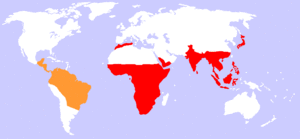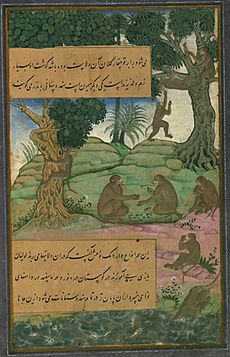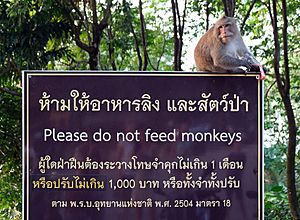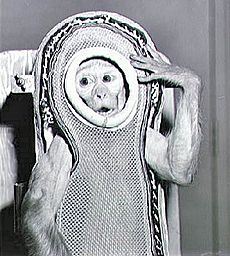Monkey facts for kids
Quick facts for kids Monkeys |
|
|---|---|
 |
|
| A Barbary macaque Macaca sylvanus |
|
| Scientific classification | |
| Kingdom: | |
| Phylum: | |
| Class: | |
| Order: | |
| Suborder: | |
| Infraorder: | |
| Groups | |
 |
|
| worldwide distribution of monkeys. | |
Monkeys are amazing mammals that often live in trees. They belong to a group of animals called primates. Monkeys are known for being smart and living in groups. Most monkeys have a tail, which can be long or short.
The word "monkey" isn't a scientific term. It describes two main groups of primates: Old World monkeys and New World monkeys. Both groups are part of a larger family called Simiiformes, which also includes apes and humans.
Contents
What are Monkeys?
Monkeys are very social animals. They live in groups called "troops" or "tribes." Some monkeys spend almost all their time in trees. Others live partly on the ground.
Monkeys mostly eat plants, especially fruit. But they can also eat many other things, like insects. You can find monkeys in forests and savannahs. They don't live in deserts. Some even live in snowy mountains, but most prefer warm rainforests. You won't find monkeys in the rainforests of Australia or New Guinea.
Monkeys come in many sizes. The smallest monkey is the pygmy marmoset. It's only about 15 centimeters (6 inches) long and weighs about 120 grams (4 ounces). The largest monkey is the mandrill. It can be about 1 meter (3 feet) long and weigh up to 35 kilograms (77 pounds).
Where Do Monkeys Live?
The two main groups of monkeys live in different parts of the world.
- New World Monkeys live in South America.
- Old World Monkeys live mostly in Africa and Asia.
New World Monkeys are often smaller than Old World Monkeys. Monkeys have long arms and legs. These help them swing easily through trees. Some monkeys have special tails that can wrap tightly around branches. This kind of tail is called a 'prehensile' tail. It works almost like a fifth limb!
Types of Monkeys
Scientists classify living primates into different groups. Here's a simplified look at where monkeys fit in:
- Order Primates
- Suborder Haplorhini (includes tarsiers, monkeys, and apes)
- Infraorder Simiiformes (simians)
- Parvorder Platyrrhini: These are the New World monkeys.
- Infraorder Simiiformes (simians)
- Suborder Haplorhini (includes tarsiers, monkeys, and apes)
* Family Callitrichidae: Like marmosets and tamarins (42 species). * Family Cebidae: Includes capuchins and squirrel monkeys (14 species). * Family Aotidae: These are night monkeys (11 species). * Family Pitheciidae: Such as titis, sakis, and uakaris (41 species). * Family Atelidae: This group has howler, spider, and woolly monkeys (24 species).
-
-
-
- Parvorder Catarrhini
-
-
* Superfamily Cercopithecoidea: These are the Old World monkeys. ** Family Cercopithecidae: Old World monkeys (135 species). * Superfamily Hominoidea: This group includes apes like gibbons, humans, gorillas, chimpanzees, and orangutans.
Monkey Diet and Habits
Monkeys eat different foods depending on their species. Their diet can include:
- Fruits
- Leaves
- Seeds
- Nuts
- Flowers
- Eggs
- Small animals like insects and spiders
Most New World monkeys have long tails that can grasp things. Old World monkeys have tails that cannot grasp, or they have no visible tail at all. Both New and Old World monkeys have eyes that face forward. However, their faces look quite different. Each group has unique features like nose shapes, cheeks, and rumps.
Monkeys and Humans
Monkeys and humans interact in many ways. Some monkeys are kept as pets. Others are used in scientific studies or even in space missions. Monkeys can also be trained to help people with disabilities.
In some places, monkeys are seen as pests because they can damage farm crops. This can make it hard to protect endangered monkey species. Monkeys that are used to humans in tourist areas might also bother people.
Monkeys Helping People
Some groups train capuchin monkeys to help people with severe spinal cord injuries or other physical challenges. These monkeys learn to do daily tasks like:
- Feeding
- Getting objects
- Moving things
- Helping with personal care
These helper monkeys are trained for many years. They can serve for 25 to 30 years, which is much longer than a guide dog. However, in the United States, non-human primates are no longer officially recognized as service animals. This is due to concerns about their well-being and the risk of injuries or diseases they might pass to humans.
Monkeys in Experiments
Monkeys are sometimes used in scientific research. The most common types are the grivet, rhesus macaque, and crab-eating macaque. They are used because they are relatively easy to handle. They also reproduce quickly and are similar to humans in some ways.
Around the world, about 100,000 to 200,000 non-human primates are used in research each year. This is a very small number compared to all animals used in research.
Monkeys in Space
Several countries have sent monkeys into space as part of their space programs. The United States and France are two examples. The first monkey in space was Albert II. He flew on a US rocket on June 14, 1949.
Monkeys as Food
In some parts of South Asia, Africa, and China, monkey meat is eaten. In traditional Islamic dietary laws, eating monkeys is forbidden.
Monkeys in Stories and Beliefs

Monkeys appear in many stories, TV shows, and movies.
- Sun Wukong, the "Monkey King," is a famous character in Chinese mythology. He is the main hero in the classic novel Journey to the West.
- The TV show Monkey and characters like Curious George also feature monkeys.
- The winged monkeys are well-known characters in the Wizard of Oz stories and the 1939 film.
Religion and Worship
Monkeys are important in many religions and beliefs.
- In Jainism, the monkey is the symbol of the fourth Tirthankara, Abhinandananatha.
- Hanuman is a powerful monkey god in Hinduism. People believe he gives courage, strength, and a long life.
- In Buddhism, the monkey can represent trickery or an early form of Buddha. The "mind monkey" is a Chinese Buddhist idea for the restless human mind.
- The Sanzaru, or three wise monkeys, are famous in Japanese folklore. They stand for "see no evil, hear no evil, speak no evil."
- The Moche people of ancient Peru worshipped nature and often showed monkeys in their art.
- The Tzeltal people of Mexico believed monkeys were their dead ancestors.
Zodiac
The Monkey (猴) is the ninth animal in the twelve-year cycle of the Chinese zodiac. This cycle is linked to the Chinese calendar.
Images for kids
-
The Barbary macaque is also known as the Barbary ape.
See also
 In Spanish: Mono para niños
In Spanish: Mono para niños







